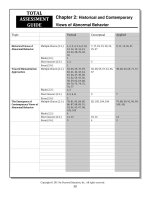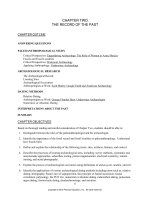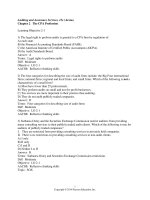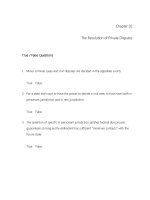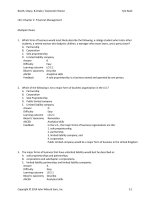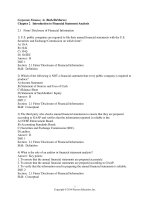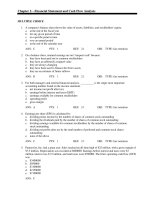Corporate finance foundations global edition 15th edition block test bank
Bạn đang xem bản rút gọn của tài liệu. Xem và tải ngay bản đầy đủ của tài liệu tại đây (2.62 MB, 98 trang )
Chapter 02
Review of Accounting
True / False Questions
1.
The income statement is the major device for measuring the profitability of a firm over a period of
time.
True
2.
The income statement measures the increase in the assets of a firm over a period of time.
True
3.
False
Sales minus cost of goods sold is equal to gross profit.
True
5.
False
Sales minus cost of goods sold is equal to earnings before taxes.
True
4.
False
False
It is not possible for a company with a high gross profit margin to have a low operating profit.
True
False
2-1
Copyright © 2014 McGraw-Hill Education. All rights reserved. No reproduction or distribution without the prior written consent of
McGraw-Hill Education.
6.
Operating profit is essentially a measure of how efficient management is in generating revenues
and controlling expenses.
True
7.
Dividing operating profit by shares outstanding produces earnings per share.
True
8.
False
Accounting income is based on verifiably completed transactions.
True
9.
False
False
The P/E ratio is strongly related to the past performance of the firm.
True
False
10. When a firm has a sharp drop off in earnings, its P/E ratio may be artificially high.
True
False
11. The P/E ratio provides no indication of investors' expectations about the future of a company.
True
False
12. The real value of a firm is the same from an economic and accounting perspective.
True
False
2-2
Copyright © 2014 McGraw-Hill Education. All rights reserved. No reproduction or distribution without the prior written consent of
McGraw-Hill Education.
13. A balance sheet represents the assets, liabilities, and owner's equity of a company at a given point
in time.
True
False
14. The investments account includes marketable securities.
True
False
15. The investments account represents a commitment of funds of at least one year or more.
True
False
16. Asset accounts are listed in order of their liquidity.
True
False
17. Accumulated depreciation shows up in the income statement.
True
False
18. Accumulated depreciation should always be equal to the depreciation expense charged in the
income statement.
True
False
19. Total assets of a firm are financed with liabilities and stockholders' equity.
True
False
2-3
Copyright © 2014 McGraw-Hill Education. All rights reserved. No reproduction or distribution without the prior written consent of
McGraw-Hill Education.
20. Marketable securities are temporary investments of excess cash and are valued at their original
purchase price.
True
False
21. Book value per share and market value per share are usually the same dollar amount.
True
False
22. Book value per share is of greater concern to the financial manager than market value per share.
True
False
23. Book value is equal to net worth.
True
False
24. Equity is a measure of the monetary contributions that have been made directly or indirectly on
behalf of the owners of the company.
True
False
25. Stockholders' equity is equal to liabilities plus assets.
True
False
26. Stockholders' equity is equal to assets minus liabilities.
True
False
2-4
Copyright © 2014 McGraw-Hill Education. All rights reserved. No reproduction or distribution without the prior written consent of
McGraw-Hill Education.
27. Stockholders' equity minus preferred stock is the same thing as what is sometimes called net worth
or book value.
True
False
28. Retained earnings shown on the balance sheet represents available cash on hand generated from
prior year's earnings but not paid out in dividends.
True
False
29. Preferred stock is excluded from stockholders' equity because it does not have full voting rights.
True
False
30. Retained earnings represent the firm's cumulative earnings since inception, minus dividends and
other adjustments.
True
False
31. Balance sheet items are required to be adjusted for inflation.
True
False
32. "Cash flow" consists of illiquid cash equivalents that are difficult to convert to cash within 90 days.
True
False
33. The statement of cash flows helps measure how the changes in a balance sheet were financed
between two time periods.
True
False
2-5
Copyright © 2014 McGraw-Hill Education. All rights reserved. No reproduction or distribution without the prior written consent of
McGraw-Hill Education.
34. Cash flow is equal to earnings before taxes minus depreciation.
True
False
35. An increase in an asset represents a source of funds.
True
False
36. Assume that two companies both have a net income of $100,000. The firm with the highest
depreciation expense will have the highest cash flow, assuming all other adjustments are equal.
True
False
37. An increase in inventory represents a source of funds.
True
False
38. An increase in a liability account represents a source of funds on the cash flow statement.
True
False
39. An increase in accounts receivable represents a reduction in cash flows from operations.
True
False
40. An increase in accounts payable represents a reduction in cash flows from operations.
True
False
2-6
Copyright © 2014 McGraw-Hill Education. All rights reserved. No reproduction or distribution without the prior written consent of
McGraw-Hill Education.
41. The purchase of a new factory would reduce the cash flows from investing activities on the
statement of cash flows.
True
False
42. The sale of corporate bonds held by the firm as a long-term investment would increase cash flows
from investing activities on the statement of cash flows.
True
False
43. Paying dividends to common shareholders will not affect cash flows from financing activities.
True
False
44. The sale of a firm's securities is a source of funds, whereas the payment of dividends is a use of
funds.
True
False
45. Depreciation is an accounting entry and does not involve a cash expense.
True
False
46. The use of depreciation is an attempt to allocate the past and future costs of an asset over its useful
life.
True
False
47. Free cash flow is equal to cash flow from operating activities plus depreciation.
True
False
2-7
Copyright © 2014 McGraw-Hill Education. All rights reserved. No reproduction or distribution without the prior written consent of
McGraw-Hill Education.
48. Free cash flow is equal to cash flow from operating activities minus necessary capital expenditures
and normal dividend payments.
True
False
49. The guidelines of the International Accounting Standards Board have been successfully reconciled
with the rules of the FASB in the United States as of 2010.
True
False
50. For corporations with low taxable income (less than $100,000), the effective tax rate can be as much
as 40%.
True
False
51. Interest expense is deductible before taxes and therefore has an after-tax cost equal to the interest
paid times (1 - tax rate).
True
False
52. Federal corporate tax rates have changed several times since 1980.
True
False
53. A $125,000 credit sale could be a part of a firm's cash flow from operations if paid off within the
firm's fiscal year.
True
False
54. Preferred stock dividends are paid out before income taxes.
True
False
2-8
Copyright © 2014 McGraw-Hill Education. All rights reserved. No reproduction or distribution without the prior written consent of
McGraw-Hill Education.
55. Net working capital is the difference between current assets and current liabilities.
True
False
56. Book value per share is the most important measure of value for a stockholder.
True
False
57. An increase in accounts receivable results in a cash inflow on the statement of cash flows.
True
False
58. A decrease in bonds payable results in a cash outflow on the statement of cash flows.
True
False
59. An increase in accrued expenses results in a cash outflow on the statement of cash flows.
True
False
60. A cash flow statement is considered correct if the net cash flow ties to the ending cash balance.
True
False
61. Although depreciation does not provide cash to the firm directly, the fact that it is tax-deductible
can provide cash inflow to the company.
True
False
Multiple Choice Questions
2-9
Copyright © 2014 McGraw-Hill Education. All rights reserved. No reproduction or distribution without the prior written consent of
McGraw-Hill Education.
62. Gross profit is equal to
A. sales minus cost of goods sold.
B. sales minus (selling and administrative expenses).
C. sales minus (cost of goods sold and selling and administrative expenses).
D. sales minus (cost of goods sold and depreciation expense).
63. Which of the following is not subtracted in arriving at operating income?
A. Interest expense
B. Cost of goods sold
C. Depreciation
D. Selling and administrative expense
64. Increasing interest expense will have what effect on EBIT?
A. Increase it.
B. Decrease it.
C. It will have no effect.
D. There is not enough information to tell.
65. The residual income of the firm belongs to
A. creditors.
B. preferred stockholders.
C. common stockholders.
D. bondholders.
2-10
Copyright © 2014 McGraw-Hill Education. All rights reserved. No reproduction or distribution without the prior written consent of
McGraw-Hill Education.
66. Allen Lumber Company had earnings after taxes of $750,000 in the year 2009 with 300,000 shares
outstanding on December 31, 2009. On January 1, 2010, the firm issued 50,000 new shares. Because
of the proceeds from these new shares and other operating improvements, 2010 earnings after
taxes were 25 percent higher than in 2009. Earnings per share for the year 2010 were
A. $2.14.
B. $2.68.
C. $3.13.
D. None of the options.
67. Consider the following information for Ball Corp.
What is the operating profit for Ball Corp.?
A. $71,450
B. $90,000
C. $130,000
D. None of the options
2-11
Copyright © 2014 McGraw-Hill Education. All rights reserved. No reproduction or distribution without the prior written consent of
McGraw-Hill Education.
68. Candy Company had sales of $320,000 and cost of goods sold of $112,000. What is the gross profit
margin (ratio of gross profit to sales)?
A. 55%
B. 65%
C. 73.3%
D. None of the options
69. Density Farms Inc. had sales of $750,000, cost of goods sold of $200,000, selling and administrative
expense of $70,000, and operating profit of $150,000. What was the value of depreciation
expense?
A. $150,000
B. $230,000
C. $330,000
D. None of the options
70. Elgin Battery Manufacturers had sales of $1,000,000 in 2009 and their cost of goods sold
represented 70 percent of sales. Selling and administrative expenses were 10 percent of sales.
Depreciation expense was $100,000 and interest expense for the year was $10,000. The firm's tax
rate is 30 percent. What is the dollar amount of taxes paid?
A. $30,000
B. $117,800
C. $27,000
D. None of the options
2-12
Copyright © 2014 McGraw-Hill Education. All rights reserved. No reproduction or distribution without the prior written consent of
McGraw-Hill Education.
71. A firm has $1,500,000 in its common stock account and $1,000,000 in its paid-in capital account.
The firm issued 100,000 shares of common stock. What was the original issue price if only one stock
issue has ever been sold?
A. $35 per share
B. $25 per share
C. $15 per share
D. Not enough information to determine
72. A firm has $4,000,000 in its common stock account and $10,000,000 in its paid-in capital account.
The firm issued 1,000,000 shares of common stock. What is the par value of the common stock?
A. $40 per share
B. $10 per share
C. $4 per share
D. $14 per share
73. A firm with earnings per share of $3 and a price-earnings ratio of 20 will have a stock price of
A. $60.00.
B. $15.00.
C. $6.67.
D. The market assigns a stock price independent of EPS and the P/E ratio.
2-13
Copyright © 2014 McGraw-Hill Education. All rights reserved. No reproduction or distribution without the prior written consent of
McGraw-Hill Education.
74. Earnings per share is
A. operating profit divided by number of shares outstanding.
B. net income divided by number of shares outstanding.
C. net income divided by stockholders' equity.
D. net income minus preferred dividends divided by number of shares outstanding.
75. Reinvested funds from retained earnings theoretically belong to
A. bond holders.
B. common stockholders.
C. employees.
D. All of the options
76. The firm's price-earnings (P/E) ratio is influenced by its
A. capital structure.
B. earnings volatility.
C. sales, profit margins, and earnings.
D. All of the options
77. When a firm's earnings are falling more rapidly than its stock price, its P/E ratio will
A. remain the same.
B. go up.
C. go down.
D. either go up or down.
2-14
Copyright © 2014 McGraw-Hill Education. All rights reserved. No reproduction or distribution without the prior written consent of
McGraw-Hill Education.
78. Which of the following factors do not influence the firm's P/E ratio?
A. Past earnings
B. Shares outstanding
C. Volatility in performance
D. None of the options
79. Which of the following would not be classified as a current asset?
A. Marketable securities
B. Investments
C. Prepaid expenses
D. Inventory
80. An item which may be converted to cash within one year or one operating cycle of the firm is
classified as a
A. current liability.
B. long-term asset.
C. current asset.
D. long-term liability.
81. Which of the following would not be included in the balance sheet investment account?
A. Stocks of other corporations
B. Long-term government bonds
C. Marketable securities
D. Investments in other corporations
2-15
Copyright © 2014 McGraw-Hill Education. All rights reserved. No reproduction or distribution without the prior written consent of
McGraw-Hill Education.
82. Asset accounts on the balance sheet are listed in order of
A. liquidity.
B. profitability.
C. size.
D. importance.
83. Which of the following is not a primary source of capital to the firm?
A. Assets
B. Common stock
C. Preferred stock
D. Bonds
2-16
Copyright © 2014 McGraw-Hill Education. All rights reserved. No reproduction or distribution without the prior written consent of
McGraw-Hill Education.
84. How many of the following balance sheet items are classified as current?
• Retained earnings
• Accounts payable
• Plant and equipment
• Inventory
• Common stock
• Bonds payable
• Accrued wages payable
• Accounts receivable
• Preferred stock
A. Three of these items are classified as current.
B. Four of these items are classified as current.
C. Five of these items are classified as current.
D. Six of these items are classified as current.
2-17
Copyright © 2014 McGraw-Hill Education. All rights reserved. No reproduction or distribution without the prior written consent of
McGraw-Hill Education.
85. How many of the following items are found on the balance sheet, rather than the income
statement?
• Accounts receivable
• Retained earnings
• Income tax expense
• Accrued expenses
• Cash
• Selling and administrative expenses
• Plant and equipment
• Operating expense
• Marketable securities
• Interest expense
A. Three of these items are found on the balance sheet.
B. Four of these items are found on the balance sheet.
C. Five of these items are found on the balance sheet.
D. Six of these items are found on the balance sheet.
2-18
Copyright © 2014 McGraw-Hill Education. All rights reserved. No reproduction or distribution without the prior written consent of
McGraw-Hill Education.
86. How many of the following items are found on the income statement, rather than the balance
sheet?
• Sales
• Notes payable (six months)
• Bonds payable, maturity 2001
• Common stock
• Depreciation expense
• Inventories
• Capital in excess of par value
• Net income (earnings after taxes)
• Income tax payable
A. Two of these items are found on the income statement.
B. Three of these items are found on the income statement.
C. Four of these items are found on the income statement.
D. Five of these items are found on the income statement.
87. Which account represents the cumulative earnings of the firm since its formation, minus dividends
paid?
A. Paid-in capital
B. Common stock
C. Retained earnings
D. Accumulated depreciation
2-19
Copyright © 2014 McGraw-Hill Education. All rights reserved. No reproduction or distribution without the prior written consent of
McGraw-Hill Education.
88. The major limitation of financial statements is
A. their complexity.
B. their lack of comparability.
C. their use of historical cost accounting.
D. their lack of detail.
89. Net worth is equal to stockholders' equity
A. plus dividends.
B. minus preferred stock.
C. plus preferred stock.
D. minus liabilities.
90. Book value is the same as
A. stockholders' equity.
B. fixed assets minus long-term debt.
C. net worth.
D. current assets minus current debt.
91. Total stockholders' equity consists of
A. preferred stock and common stock.
B. common stock and retained earnings.
C. common stock and capital paid in excess of par.
D. preferred stock, common stock, capital paid in excess of par, and retained earnings.
2-20
Copyright © 2014 McGraw-Hill Education. All rights reserved. No reproduction or distribution without the prior written consent of
McGraw-Hill Education.
92. The net worth of a firm
A. is usually the same as the firm's market value.
B. is based on current asset costs.
C. is based on current liabilities.
D. None of the options
93. The orientation of book value per share is ________, while the orientation of market value per share
is _________.
A. short term; long term
B. future; historical
C. historical; future
D. long term; short term
94. The primary disadvantage of accrual accounting is that
A. it does not match revenues and expenses in the period in which they are incurred.
B. it does not appropriately measure accounting profit.
C. it does not recognize accounts receivable.
D. it does not adequately show the actual cash flows of the firm.
95. The statement of cash flows does not include which of the following sections?
A. Cash flows from operating activities
B. Cash flows from sales activities
C. Cash flows from investing activities
D. Cash flows from financing activities
2-21
Copyright © 2014 McGraw-Hill Education. All rights reserved. No reproduction or distribution without the prior written consent of
McGraw-Hill Education.
96. Which of the following is an outflow of cash?
A. Profitable operations
B. The sale of equipment
C. The sale of the company's common stock
D. The payment of cash dividends
97. Which of the following is an inflow of cash?
A. Funds spent in normal business operations
B. The purchase of a new factory
C. The sale of the firm's bonds
D. The retirement of the firm's bonds
98. A statement of cash flows allows a financial analyst to determine
A. whether a cash dividend is affordable.
B. how increases in asset accounts have been financed.
C. whether long-term assets are being financed with long-term or short-term financing.
D. All of the options
99. Which of the following would represent a use of funds and, indirectly, a reduction in cash
balances?
A. An increase in inventories
B. A decrease in marketable securities
C. An increase in accounts payable
D. The sale of new bonds by the firm
2-22
Copyright © 2014 McGraw-Hill Education. All rights reserved. No reproduction or distribution without the prior written consent of
McGraw-Hill Education.
100. Which of the following would represent a source of funds and, indirectly, an increase in cash
balances?
A. A reduction in accounts receivable
B. The repurchase of shares of the firm's stock
C. A decrease in net income
D. A reduction in notes payable
101. A firm's purchase of plant and equipment would be considered a
A. use of cash for financing activities.
B. use of cash for operating activities.
C. source of cash for investment activities.
D. use of cash for investment activities.
102. An increase in investments in long-term securities will
A. increase cash flow from investing activities.
B. decrease cash flow from investing activities.
C. increase cash flow from financing activities.
D. decrease cash flow from financing activities.
2-23
Copyright © 2014 McGraw-Hill Education. All rights reserved. No reproduction or distribution without the prior written consent of
McGraw-Hill Education.
103. How many of the following items decrease cash flow in the statement of cash flows?
• Increase in accounts receivable
• Increase in notes payable
• Depreciation expense
• Increase in investments
• Decrease in accounts payable
• Decrease in prepaid expenses
• Dividend payment
• Increase in accrued expenses
A. Two of these items decrease cash flow
B. Three of these items decrease cash flow
C. Four of these items decrease cash flow
D. Five of these items decrease cash flow
104. Depreciation is a source of cash inflow because
A. it is a non-cash expense.
B. it supplies cash for future asset purchases.
C. it is a tax-deductible cash expense.
D. it is a taxable expense.
105. Depreciation tends to
A. increase cash flow and decrease income.
B. decrease cash flow and increase income.
C. affect only cash flow.
D. affect only income.
2-24
Copyright © 2014 McGraw-Hill Education. All rights reserved. No reproduction or distribution without the prior written consent of
McGraw-Hill Education.
106. Preferred stock dividends __________ earnings available to common stockholders.
A. increase
B. decrease
C. do not effect
D. There is not enough information to determine.
107. Free cash flow is equal to
A. cash flow from operating activities plus capital expenditures, minus dividends.
B. cash flow from operating activities plus capital expenditures, plus dividends.
C. cash flow from operating activities plus dividends, minus capital expenditures.
D. cash flow from operating activities minus capital expenditures, minus dividends.
108. In the last decade, free cash flow has been associated with special financial activities such as
A. leveraged buyouts.
B. ESOPs.
C. stock options.
D. golden parachutes.
109. Free cash flow is equal to cash flow from operating activities
A. plus capital expenditures, minus dividends.
B. minus capital expenditures, plus dividends.
C. plus capital expenditures, plus dividends.
D. minus capital expenditures, minus dividends.
2-25
Copyright © 2014 McGraw-Hill Education. All rights reserved. No reproduction or distribution without the prior written consent of
McGraw-Hill Education.

